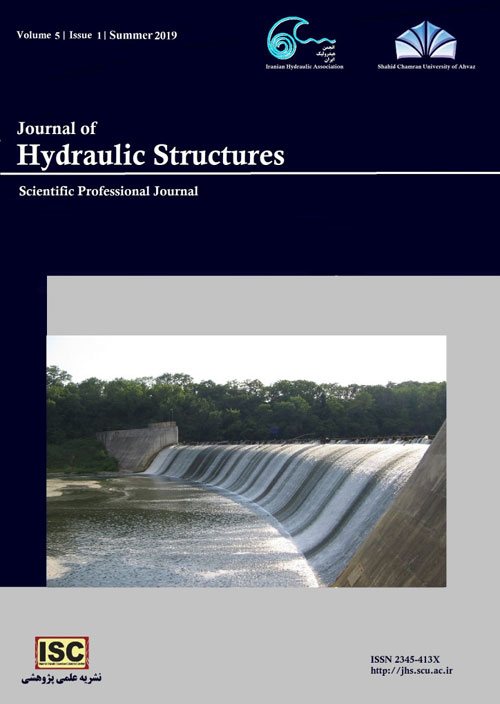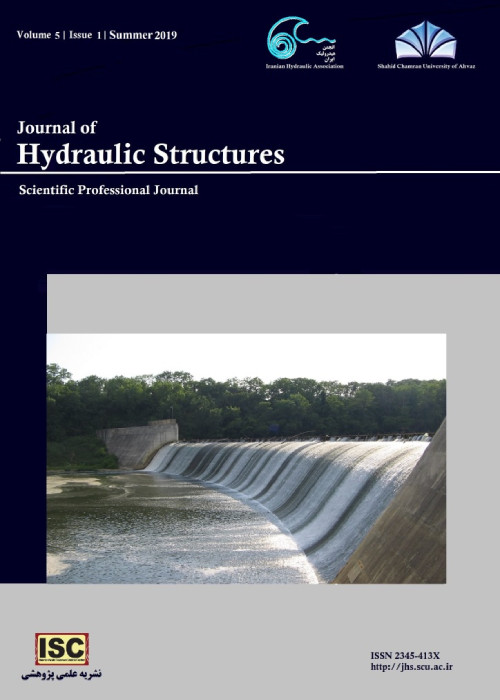فهرست مطالب

Journal of Hydraulic Structures
Volume:7 Issue: 1, Spring 2021
- تاریخ انتشار: 1400/04/15
- تعداد عناوین: 6
-
-
Pages 1-15
A tunnel spillway is one of the spillway types in which a high free surface flow velocity is established. The pressure increases in concave vertical bends due to the rotational acceleration and the nature of irregularities in the turbulent flow. Physical models are the best tools to analyze this phenomenon. The number of the required physical models to cover all practical prototype condition analysis is so large that makes it impractical in terms of placement and costs. Therefore, the FLOW-3D software has been chosen to analyze and produce a database of turbulent flow in tunnels concave bends covering all possible practical alternatives. Various tunnels with different discharges and geometries have been simulated by this software. The numerical results were verified with the experimental ones of the constructed physical model of Alborz Dam tunnel spillway, and a satisfactory agreement was obtained. Dimensional analysis is used to group the involved variables of the problem into dimensionless parameters. These parameters are utilized in the artificial neural network simulation. The results showed a correlation coefficient R2=0.95 between the dimensionless parameters obtained by the Flow-3D software and those predicted by the neaural network which leads to the conclusion that the artificial neural network based on the database obtained by the turbulent flow modeling in this regard is a powerful tool for pressure prediction.
Keywords: Flow-3D, Tunnel spillway concave bend, Numerical simulation, Turbulent Flow, Artificial neural network -
Pages 16-37The present study employs a mathematical method, i.e. Particle Filter (PF), to accurately estimate the parameters of three standard aquifers. The method is linked to a new developed numerical method, i.e. meshless local Petrov-Galerkin based on the moving kriging method (PF-MLPG-MK), to determine the aquifer parameters such as hydraulic conductivity coefficient, transmissivity coefficient, and storage coefficient or specific yield appropriately. For this purpose, a set of particles scattered in the state space. Each particle has two features: location and weight. Particles with greater weight values have the closer location to the estimation. Weight values which are assigned to each particle is computed based on the maximum likelihood function. This function is calculated in MLPG-MK simulation model. Overall, by linking particle filter model to the accurate simulation model, an efficient estimation method for aquifer parameters is obtained. This model applied to three standard aquifers. In the first standard aquifer, the estimated parameters of hydraulic conductivity and specific yield were 30.21 and 0.143, respectively. However, the exact values are 30 and 0.15. Also, in the second standard aquifer, the predicted transmissivity and storage coefficients were 99.7038 and 0.001057 whereas their true values are 100 and 0.001. In the third aquifer, the exact value of six parameters were achieved. The sensitivity analysis of the number of particles was carried out. Results revealed that with increasing the particles more accuracy will be achieved. 60, 80 and 100 particles were considered in the model. Results for 100 particles showed more accuracy.Keywords: Aquifer Hydrodynamic Parameters, Groundwater modelling, Particle Filter, Meshless Local Petrov-Galerkin
-
Pages 38-58In this paper, the performance of the MIKE21 numerical model in modeling the dispersion and transport of spilt oil related to the Deep-Water Horizon oil platform disaster in the northern part of the Gulf of Mexico is studied. Our model predicts the distribution and movement of spilt oil based on the wind-waves, current flows and vorticities taking into account evaporation, emulsion, and absorption. In this research, two types of large scale and local scale models are considered. The radiation stress of the waves, the water level and the flow speed in the Gulf are modeled using a large-scale model. After calibration and verification, the large-scale model is used to extract the boundary conditions for the local scale model and the dispersion and transport of the spilt oil is done in the local model. The accuracy of the numerical simulation using MIKE21 are confirmed by comparisons to observed satellite images. Results showed that the length of the oil spill reached 55 kilometers and covered an area of 2,800 Km2 by April 25. After two weeks, the oil spill had apparently divided into two slicks, each with an area of about 2420 and 960 Km2, respectively. Eventually, by May 28, the slick area appeared to reach over 48,400 Km2 which much of the oil evaporated because it was lightweight oil. Meanwhile, the Deep-Water Horizon oil spill occurred in spring and summer seasons; we also consider possible results assuming that the spill occurred at other times, such as autumn or winter.Keywords: Deep water Horizon oil spill, satellite images of spilt oil, spectral wave model, vorticities, Gulf of Mexico
-
Pages 59-76Seepage is one of the most substantial factors in the embankment dams design. The Cutoff wall method is the ideal construction solution for controlling flow through the foundation of earth dams. In this study, the cutoff wall method is investigated at the site of the Peygham-Chay dam (Study area). According to the dam site, in terms of its materials as well as their different permeability, water influx is a potential hazard at the site. For this purpose, SEEP/W program as the finite element approach was employed to estimate the seepage and design of the optimum depth of the sealing element. The results of numerical analyzes imply that the sealing component is not needed because of the low permeability in the primary 260 m at the left abutment of the dam. Also, the optimum depth of the cutoff wall is evaluated as 15 m at the rest of the dam axis.Keywords: Cutoff wall, Dam site, Peygham-Chay dam, sealing methods, Water seepage
-
Pages 77-97Considering the importance of the effect of elevated tank body strength on the seismic performance of model during an earthquake, this research evaluated the effect of Young Modulus of body concrete and foundation as strength parameters on seismic performance of elevated tanks and examines the responses to achieve the optimal body stiffness using probabilistic analysis as an effective method to know the effect of different parameters on the output responses. The system is modeled and analyzed by ANSYS software based on the finite element method. The applied approaches included the Newark method for time integration of the dynamic analysis and the probabilistic analysis using the Latin Hypercube sampling method (LHS). Accordingly, first, the modulus of the elasticity of the tank body and foundation were considered as the input parameters. Seismic responses of the model due to Manjil earthquake ground motions are compared with each other. Obtained results illustrated the capability of presented finite element model. The obtained results of the probabilistic analysis indicate the sensitivity of responses to the variation of the flexibility of the tank foundation. Increasing the modulus of elasticity of concrete enhances the principle stresses on tank body and decreases tank displacement. According to the diagrams, changes in the modulus of the elasticity of the tank have a significant effect on the response values, and the percentage of response variations is high. However, the variations in modulus of the elasticity have little effect on the values of the output responses.Keywords: Elevated tank, LHS simulation, Modulus of elasticity, Seismic Performance
-
Pages 98-113Experiment design is believed to be an important part of investigating an engineering phenomenon for characterizing and optimizing the process. In this study, the Taguchi method (TM) reduced the number of experiments and was used to analyze the results of an artificial neural network (ANN) and find the optimal combination of the relevant parameters in the ANN. Accordingly, the phenomenon of the local scour depth around the bridge during flood events was considered as a case study. The study results indicated that TM could reduce the number of experiments compared to the previous original study and the full factorial method by 28% and 67%, respectively. According to TM, the flow intensity at the hydrograph peak was the most effective parameter providing the optimal state (minimum scour depth). Additionally, an ANN with three hidden layers and the main parameters, including several neurons in the first and second hidden layers, training function, and transfer function, was introduced. Adjusting the input parameters of the ANN, TM led to the emergence of networks with a reasonable correlation coefficient of R= 0.952. Finally, the results demonstrated that the transfer function had the most significant effect on the results of the ANN.Keywords: Taguchi method, Artificial neural network, Scour depth, Bridge piers, Flood flow


